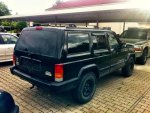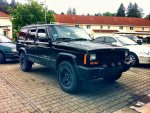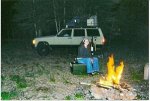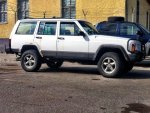There is obviously a business to be run by Expedition Portal / Overland Journal and I think they do a great job - I'm always checking the site, reading reviews and gawking over decked out Land Cruisers, Rubicon Wranglers and more. However, when it comes to my own hard-earned dollars, I have to draw the line at things like a $200 camp chair or self-activating sway-bar disconnects and, at least for me, that extends into the realm of what type of vehicle I can actually afford to own and maintain.
So, if you look beyond the catering to manufacturers' sponsorships and aftermarket dealers' ad dollars that keep EP and OJ going, I feel like the focus on brand new, extremely expensive and heavily outfitted vehicles is overlooking a very obvious contender for the Overlanding crown and one that is attainable for us mere mortals: the 4.0 Liter, 4-wheel drive Jeep Cherokee XJ.
I hope you'll indulge me and maybe throw in your 2 cents as I go on a minor rant about how badly overlooked the Cherokee is for expedition and overland travel and, maybe, just maybe, Expedition Portal will do a feature on USED or BUDGET Overland Vehicles. (EDIT: As a commenter has pointed out below, EP did do a Used Overland Vehicles rundown but, in addition to featuring the same vehicles as in any "New" segments, the fact that the Jeep Compass somehow edges out the Cherokee for inclusion makes this post of mine all the more relevant.) I'm not going to delve into every single detail and I'm sure folks will take issue with many of my points, but I really just want to round out the picture of great Overlanders to include a car that I know and love. Okay, here goes.
Stage 1 - Pedigree
The term "Sport Utility Vehicle" was literally invented by the Jeep Cherokee when first used in a 1974 sales brochure for the XJ's predecessor, the Jeep "SJ" 2-door wagon. This was also the first year of FourWheeler Magazine's "Four Wheeler of the Year Award" which went to, you guessed it, the Jeep SJ Cherokee. The evolution of this design into a light-weight, but rigid unibody frame and chassis yielded the release of the XJ Cherokee in 1984 and all other carmakers scrambled to copy it. I point this out because one of the first things to be mentioned in so many overviews of these $40,000 Land Cruiser/Rovers/etc is their pedigree and history of excellence - true, but I don't know how you overlook the vehicle that created the category. Just ask the guys at Top Gear in this comically British, but equally awesome roadtest (YouTube link).
Image: The XJ Cherokee's forefather, the SJ Jeep Cherokee Chief.

Stage 2 - Stock Performance
Development and breed aside, the Cherokee is an insanely capable 4x4 even with a bone stock setup. I've seen XJ's with sagging rear-springs and 23" bald tires go straight up the side of a rock-slide, through hood level water, 3 feet of snow and, once on road, even do 0-60 in an impressive 9 seconds (check out the infamous Michigan State Police speed tests for some shocking XJ performance numbers). I would never suggest against modifying this vehicle because there's just too many options for performance enhancement and it's just too damn fun, but I doubt there's many so-called SUVs out there that could confidently take you off-road and over-land without significant investment up front like this one. My point is, if you don't have a lot of money to sink into build features up-front like so many of us, this is a great place to start.
Video: Incredulous off-roaders watch this XJ stocker climb.
Stage 3 - Reliability
Now we're heading more into the territory of what separates an overlander from an off-roader. So many folks will trailer some monster truck rig to a trail and spend the day bashing it around, which is fine - to each their own, but in overlanding we're looking for a vehicle that gets you there, takes you into the **** and brings you back home all on the same 4 wheels and without taking crippling damage. Couldn't think of a vehicle better suited than the Cherokee. Again, I'm not going for an exhaustive feature list but a couple of key factors in the XJ's long-term performance on- and off-road are a strong timing CHAIN rather than belt, a no-frills inline 6 cylinder engine (second only to diesel engines in terms of low maintenance), a mechanical 4x4 transfer case over fussy push-button technology and relatively simple, centered front and rear axle differentials that put this 4-wheel technology to good use. Perhaps as good an indication as any of the XJ's reliability is the fact that the same Michigan State Police department officially retires their Cherokees at 300,000 miles - more than 3 TIMES the service life of their Crown Vics, Fords and Chevies.
Image: Yes, that's 500,000 as in a Half-Million Miles

Stage 4 - Transportation: Crew, Cargo and Capacity
This is where I start to go a little batty when people raise the flag for the Rubicon Unlimited (JK) 4-door as having "saved" the fatal flaw of limited space for Jeeps and being the "must have" of overland vehicles. I cry foul. You do not need to spend $30-40,000 to get a Jeep that will take you and your family overlanding, it's just not true. There are any number of dimensions to consider when it comes to transporting people, gear, food, water, etc overland effectively and efficiently, but let's just assume you're the typical overlanding couple with a dog, a kid, one of each (or two of one for that matter) and a decent amount of gear that you need to get from one place to another on only your own tank of gas. The 4-door Cherokee (there is a more rare 2-door model out there) can hold up to 5 passengers (I've done it on a 260 mile roundtrip excursion), with a crew space of 111.9 cubic feet from dash to rear seat. Almost as important is the additional 50 cubic feet of cargo space in the trunk, which immediately doubles when you're traveling as a pair and can fold down the rear seat completely flat. To put this in perspective, I have on many occasions lacking a tent shacked up in the back of my Cherokee and many other enterprising owners have been known to build fully contained sleeping platforms (Google it). Finally, even the heaviest laden Cherokee will do between 15-20 mpg depending on terrain and conditions on a 20 gallon tank giving it far superior range to any but the most efficient of diesel engines which, as we all know, are hard to come by in the great U.S. of A. Many XJ owners swear by the addition of a simple cold-air intake and high-flow exhaust to generate a limited, but significant bump in fuel economy with the added benefit of kicking in up to 10 extra horses.
Image: A Search & Rescue XJ loaded with gear but room to spare.

Stage 5 - Modification
Let's be honest, this is what we're all really here for - the pleasure that comes from planning, building and using modifications to stock vehicles for overlanding purposes is second to none. Whether it's something as essential as suspensions or as luxurious as a built-in mini-fridge, every vehicle has an innate capacity for and ease of which it can be modified. Again, I write this post mostly because I think the Cherokee has been largely overlooked in this department and I'd like to remedy that. Rather than regurgitate the work of others, I'd direct anyone interested to the best all-in-one resource I've found, Off-Road Adventure's Finessing The Jeep Cherokee, a 4 part series on the essential and most efficient structural upgrades to the Jeep XJ (just Google "Finessing The..." for Parts 2-4). Whether you do these upgrades yourself or have the help of a pro, there's proof that a relatively small investment can have you out in any terrain with the same vehicles that are touting 5 figure overhauls on a $40,000 car.
Image: Wheel articulation is a calling card of the modded Cherokee.

Conclusions & My Cherokee
If I were to guess what has held the XJ Cherokee back from inclusion on many of Overland Journal and Expedition Portal's "Best Of" or in-depth overview features is that it's no longer sold. It's a real shame and a cautionary tale of what happens when you start messing with a good thing; the short version is that some cost-slashing executive from Mercedes named Wolfgang Bernhard was brought in to reinvigorate the line and deemed it best to shake-up the product line by killing the Cherokee and replacing it with the froofy Liberty. Now how many of those do you see off-road? In the end Bernhard was promoted to the chair of Chrysler group the last I heard but, in many ways, by killing the Cherokee he created a sought after classic. The beauty for those of us mere mortals that I referenced before is that these cars can be found in abundance on any city's Craigslist, on the lots of every used dealer and in some front yard of most neighborhoods. In the absence of severe rust from salt-happy Northern states, you can pick up a functionally sound Cherokee for typically between $1,000 - 5,000 depending on year, options and the usual road wear.
Which is exactly what I did last year as I began building my Overland Expedition vehicle with the purchase of my second XJ. My first car was a 1999 Jeep Cherokee, but I had strayed from the flock when I began commuting 350 miles a week for work. So, with my replacement Civic paid off and a relocation to the mountains of Western North Carolina I went out and found the best condition, last production model 2001 Jeep Cherokee I could find. My all black "ADK_XJ", named after the Adirondack Mountains in Upstate NY that I grew up in, is just in the infancy of its build-up but it is a pleasure to drive, has been fully overhauled in the suspension with a Rusty's Offroad 3.5" lift, 30" tires and is just waiting for the addition of all the goodies that make overland vehicles so bulletproof (think bumpers, lights, recovery, storage, on-board air, battery power, towing, etc). The best part is that a year into the project I'm still well under the $10k mark for a vehicle that will literally go anywhere that shiny new production vehicles will go and then some.
Hope you got some of value out of my rant / rundown and I really would LOVE for EP to do (another) feature on used overland vehicles if they could find the advertising revenue to support it . Welcome your thoughts, comment and, for you rich bastards, don't worry - I'll still be gawking at your imported Defender 110, but I may be pulling you out of a ditch while doing it. Thanks for reading!
. Welcome your thoughts, comment and, for you rich bastards, don't worry - I'll still be gawking at your imported Defender 110, but I may be pulling you out of a ditch while doing it. Thanks for reading!
Image: My 2001 Jeep Cherokee Classic - 130,000 Miles
![photo[4].JPG photo[4].JPG](https://expeditionportal.com/forum/data/attachments/69/69980-e091091a30d462b96c13bd5ad8f1ff4a.jpg)
So, if you look beyond the catering to manufacturers' sponsorships and aftermarket dealers' ad dollars that keep EP and OJ going, I feel like the focus on brand new, extremely expensive and heavily outfitted vehicles is overlooking a very obvious contender for the Overlanding crown and one that is attainable for us mere mortals: the 4.0 Liter, 4-wheel drive Jeep Cherokee XJ.
I hope you'll indulge me and maybe throw in your 2 cents as I go on a minor rant about how badly overlooked the Cherokee is for expedition and overland travel and, maybe, just maybe, Expedition Portal will do a feature on USED or BUDGET Overland Vehicles. (EDIT: As a commenter has pointed out below, EP did do a Used Overland Vehicles rundown but, in addition to featuring the same vehicles as in any "New" segments, the fact that the Jeep Compass somehow edges out the Cherokee for inclusion makes this post of mine all the more relevant.) I'm not going to delve into every single detail and I'm sure folks will take issue with many of my points, but I really just want to round out the picture of great Overlanders to include a car that I know and love. Okay, here goes.
Stage 1 - Pedigree
The term "Sport Utility Vehicle" was literally invented by the Jeep Cherokee when first used in a 1974 sales brochure for the XJ's predecessor, the Jeep "SJ" 2-door wagon. This was also the first year of FourWheeler Magazine's "Four Wheeler of the Year Award" which went to, you guessed it, the Jeep SJ Cherokee. The evolution of this design into a light-weight, but rigid unibody frame and chassis yielded the release of the XJ Cherokee in 1984 and all other carmakers scrambled to copy it. I point this out because one of the first things to be mentioned in so many overviews of these $40,000 Land Cruiser/Rovers/etc is their pedigree and history of excellence - true, but I don't know how you overlook the vehicle that created the category. Just ask the guys at Top Gear in this comically British, but equally awesome roadtest (YouTube link).
Image: The XJ Cherokee's forefather, the SJ Jeep Cherokee Chief.

Stage 2 - Stock Performance
Development and breed aside, the Cherokee is an insanely capable 4x4 even with a bone stock setup. I've seen XJ's with sagging rear-springs and 23" bald tires go straight up the side of a rock-slide, through hood level water, 3 feet of snow and, once on road, even do 0-60 in an impressive 9 seconds (check out the infamous Michigan State Police speed tests for some shocking XJ performance numbers). I would never suggest against modifying this vehicle because there's just too many options for performance enhancement and it's just too damn fun, but I doubt there's many so-called SUVs out there that could confidently take you off-road and over-land without significant investment up front like this one. My point is, if you don't have a lot of money to sink into build features up-front like so many of us, this is a great place to start.
Video: Incredulous off-roaders watch this XJ stocker climb.
Stage 3 - Reliability
Now we're heading more into the territory of what separates an overlander from an off-roader. So many folks will trailer some monster truck rig to a trail and spend the day bashing it around, which is fine - to each their own, but in overlanding we're looking for a vehicle that gets you there, takes you into the **** and brings you back home all on the same 4 wheels and without taking crippling damage. Couldn't think of a vehicle better suited than the Cherokee. Again, I'm not going for an exhaustive feature list but a couple of key factors in the XJ's long-term performance on- and off-road are a strong timing CHAIN rather than belt, a no-frills inline 6 cylinder engine (second only to diesel engines in terms of low maintenance), a mechanical 4x4 transfer case over fussy push-button technology and relatively simple, centered front and rear axle differentials that put this 4-wheel technology to good use. Perhaps as good an indication as any of the XJ's reliability is the fact that the same Michigan State Police department officially retires their Cherokees at 300,000 miles - more than 3 TIMES the service life of their Crown Vics, Fords and Chevies.
Image: Yes, that's 500,000 as in a Half-Million Miles

Stage 4 - Transportation: Crew, Cargo and Capacity
This is where I start to go a little batty when people raise the flag for the Rubicon Unlimited (JK) 4-door as having "saved" the fatal flaw of limited space for Jeeps and being the "must have" of overland vehicles. I cry foul. You do not need to spend $30-40,000 to get a Jeep that will take you and your family overlanding, it's just not true. There are any number of dimensions to consider when it comes to transporting people, gear, food, water, etc overland effectively and efficiently, but let's just assume you're the typical overlanding couple with a dog, a kid, one of each (or two of one for that matter) and a decent amount of gear that you need to get from one place to another on only your own tank of gas. The 4-door Cherokee (there is a more rare 2-door model out there) can hold up to 5 passengers (I've done it on a 260 mile roundtrip excursion), with a crew space of 111.9 cubic feet from dash to rear seat. Almost as important is the additional 50 cubic feet of cargo space in the trunk, which immediately doubles when you're traveling as a pair and can fold down the rear seat completely flat. To put this in perspective, I have on many occasions lacking a tent shacked up in the back of my Cherokee and many other enterprising owners have been known to build fully contained sleeping platforms (Google it). Finally, even the heaviest laden Cherokee will do between 15-20 mpg depending on terrain and conditions on a 20 gallon tank giving it far superior range to any but the most efficient of diesel engines which, as we all know, are hard to come by in the great U.S. of A. Many XJ owners swear by the addition of a simple cold-air intake and high-flow exhaust to generate a limited, but significant bump in fuel economy with the added benefit of kicking in up to 10 extra horses.
Image: A Search & Rescue XJ loaded with gear but room to spare.

Stage 5 - Modification
Let's be honest, this is what we're all really here for - the pleasure that comes from planning, building and using modifications to stock vehicles for overlanding purposes is second to none. Whether it's something as essential as suspensions or as luxurious as a built-in mini-fridge, every vehicle has an innate capacity for and ease of which it can be modified. Again, I write this post mostly because I think the Cherokee has been largely overlooked in this department and I'd like to remedy that. Rather than regurgitate the work of others, I'd direct anyone interested to the best all-in-one resource I've found, Off-Road Adventure's Finessing The Jeep Cherokee, a 4 part series on the essential and most efficient structural upgrades to the Jeep XJ (just Google "Finessing The..." for Parts 2-4). Whether you do these upgrades yourself or have the help of a pro, there's proof that a relatively small investment can have you out in any terrain with the same vehicles that are touting 5 figure overhauls on a $40,000 car.
Image: Wheel articulation is a calling card of the modded Cherokee.

Conclusions & My Cherokee
If I were to guess what has held the XJ Cherokee back from inclusion on many of Overland Journal and Expedition Portal's "Best Of" or in-depth overview features is that it's no longer sold. It's a real shame and a cautionary tale of what happens when you start messing with a good thing; the short version is that some cost-slashing executive from Mercedes named Wolfgang Bernhard was brought in to reinvigorate the line and deemed it best to shake-up the product line by killing the Cherokee and replacing it with the froofy Liberty. Now how many of those do you see off-road? In the end Bernhard was promoted to the chair of Chrysler group the last I heard but, in many ways, by killing the Cherokee he created a sought after classic. The beauty for those of us mere mortals that I referenced before is that these cars can be found in abundance on any city's Craigslist, on the lots of every used dealer and in some front yard of most neighborhoods. In the absence of severe rust from salt-happy Northern states, you can pick up a functionally sound Cherokee for typically between $1,000 - 5,000 depending on year, options and the usual road wear.
Which is exactly what I did last year as I began building my Overland Expedition vehicle with the purchase of my second XJ. My first car was a 1999 Jeep Cherokee, but I had strayed from the flock when I began commuting 350 miles a week for work. So, with my replacement Civic paid off and a relocation to the mountains of Western North Carolina I went out and found the best condition, last production model 2001 Jeep Cherokee I could find. My all black "ADK_XJ", named after the Adirondack Mountains in Upstate NY that I grew up in, is just in the infancy of its build-up but it is a pleasure to drive, has been fully overhauled in the suspension with a Rusty's Offroad 3.5" lift, 30" tires and is just waiting for the addition of all the goodies that make overland vehicles so bulletproof (think bumpers, lights, recovery, storage, on-board air, battery power, towing, etc). The best part is that a year into the project I'm still well under the $10k mark for a vehicle that will literally go anywhere that shiny new production vehicles will go and then some.
Hope you got some of value out of my rant / rundown and I really would LOVE for EP to do (another) feature on used overland vehicles if they could find the advertising revenue to support it
Image: My 2001 Jeep Cherokee Classic - 130,000 Miles
![photo[4].JPG photo[4].JPG](https://expeditionportal.com/forum/data/attachments/69/69980-e091091a30d462b96c13bd5ad8f1ff4a.jpg)
Last edited:








